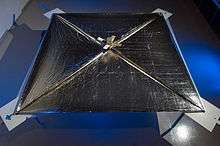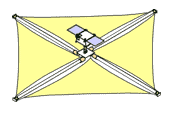LightSail 2
| Names | LightSail-1[1] |
|---|---|
| Mission type | Technology demonstration |
| Operator | The Planetary Society |
| Website |
sail |
| Spacecraft properties | |
| Bus | 3U CubeSat |
| Start of mission | |
| Launch date | Early 2019 [2] |
| Rocket | Falcon Heavy |
| Launch site | LC-39A, Kennedy Space Center |
| Contractor | SpaceX |
LightSail 2 is a project to demonstrate controlled solar sailing using a CubeSat artificial satellite, developed by The Planetary Society, a global non-profit organization devoted to space exploration.[3] The spacecraft core measures 10 × 10 × 30 cm, and its kite-shaped solar sail deploys into a total area of 32 square meters (340 sq ft).[4]
LightSail 2 is currently scheduled to be launched as a secondary payload on the Space Test Program (STP-2) on a Falcon Heavy rocket in 2019.
On May 20, 2015, a nearly identical demonstration spacecraft, LightSail 1 (formerly called LightSail-A[1]), was launched, and deployed its solar sail on June 7, 2015.
History

In 2005, The Planetary Society attempted to send a larger solar sail named Cosmos 1 into space, but the spacecraft's Russian Volna launch vehicle failed to reach orbit.[5] In 2009, the Society began working on a CubeSat-based solar sail based on NASA's NanoSail-D project,[6] which was lost in August 2008 due to the failure of its Falcon 1 launch vehicle.[7] (A second unit, NanoSail-D2, was successfully deployed in early 2011.)
By 2011, the LightSail project had passed its critical design review, which was conducted by a team including JPL project veterans Bud Schurmeier, Glenn Cunningham, and Viktor Kerzhanovich, as well as Dave Bearden of Aerospace Corporation.[8] The original estimated cost of the LightSail project was US$1.8 million, which was raised from membership dues and private sources. The prototype spacecraft LightSail 1 (or LightSail-A) was built in San Luis Obispo by Stellar Exploration Incorporated,[5] and final integration and testing prior to launch occurred at Ecliptic Enterprises Corporation in Pasadena, California.
In March 2016, The Planetary Society announced they decided to use the convention on naming the spacecraft with the program name followed by a sequential number; the test flight or LightSail-A, became LightSail 1, and the upcoming larger spacecraft is now called LightSail 2.[1]
Design
As a solar sail, LightSail 2's propulsion is dependent on solar radiation alone. Solar photons exert radiation pressure on the sail, producing a small degree of acceleration. Thus, the solar sail will be propelled by pressure from sunlight itself, and not by the charged particles of the solar wind.[9] The Planetary Society expects LightSail 2's orbit to increase by as much as a kilometer per day.[10]

Structure
LightSail 2's modular design is based on a modular three-unit CubeSat, a small satellite format created for university-level space projects. One CubeSat-sized module carries the cameras, sensors and control systems, and the other two units will contain and deploy the solar sails.[11]
The spacecraft contains four triangular sails, which combine to form a rectangular-shaped surface. The sails are made of Mylar, a reflective polyester film.[12]
LightSail 1 flight
A preliminary technology demonstrator spacecraft, LightSail 1 (formerly LightSail-A[1]), was launched as a secondary payload aboard a United Launch Alliance Atlas V rocket at 15:05 UTC on 20 May 2015 from Cape Canaveral Air Force Station, Florida.[13][14][15] The mission delivered the satellite to an orbit where atmospheric drag was greater than the force exerted by solar radiation pressure.[16]
Two days after the launch, however, the spacecraft suffered a software malfunction which made it unable to deploy the solar sail or to communicate.[17] On 31 May 2015, The Planetary Society reported having regained contact with LightSail 1.[18][19] After the solar panels were deployed on 3 June 2015, communications with the spacecraft were lost once more on 4 June. In this case, a fault with the battery system was suspected.[20] Contact was then reestablished on 6 June,[21] and the sail deployment was initiated on 7 June.[22] At a conference on 10 June 2015, after photos of deployment were downloaded, the test flight was declared a success.[23] The spacecraft reentered the atmosphere on 14 June 2015, ending the test flight.[24][25]
LightSail 2
LightSail 2 will demonstrate controlled solar sailing in Earth orbit. By controlling the orientation of the sail relative to the Sun, the flight team will attempt to raise the orbit apogee and increase orbital energy following sail deployment. The flight team will evaluate the evolution of LightSail 2's orbit after the spacecraft is deployed from a partner spacecraft, Prox-1, at an altitude of 720 kilometers.[11] Prox-1 and LightSail 2 are secondary payloads aboard the first operational SpaceX Falcon Heavy launch, which will carry the STP-2 payload for the U.S. Air Force.[26]
See also
- CubeSail
- CubeSail (UltraSail)
- IKAROS, a Japanese solar sail, launched in May 2010
- NanoSail-D2, the successor to NanoSail-D, launched in November 2010
- Near-Earth Asteroid Scout, a solar sail planned to launch in 2019
- OKEANOS, a large Japanese solar sail proposal to Jupiter Trojans
- Sunjammer, a solar sail that was cancelled before launch in 2014
References
- 1 2 3 4 Davis, Jason (1 March 2016). "Meet LightSail 2, The Planetary Society's new solar sailing CubeSat". The Planetary Society. Retrieved 2016-03-01.
- ↑ "Launch Schedule". Speaceflight Now. Retrieved 16 September 2018.
- ↑ Davis, Jason (March 3, 2017). "Signed, sealed but not delivered: LightSail 2 awaits ship date". The Planetary Society. Retrieved March 29, 2017.
- ↑ "LightSail". The Planetary Society. Retrieved 2017-03-29.
- 1 2 Antczak, John (November 9, 2009). "After letdown, solar-sail project rises again". MSNBC. Associated Press.
- ↑ Dennis Overbye (November 9, 2009). "Setting Sail Into Space, Propelled by Sunshine". The New York Times.
- ↑ "SpaceX's Falcon 1 Falters For a Third Time". Space.com. Retrieved 2017-03-29.
- ↑ Louis D. Friedman (June 25, 2010). "LightSail-1 Passes Critical Design Review". The Planetary Society.
- ↑ "Planetary Society To Sail Again With LightSail". Space Travel blog. November 10, 2009.
- ↑ "A Kilometer Per Day: LightSail Mission Managers Refine Orbit-Raising Plan". www.planetary.org. Retrieved 2017-03-29.
- 1 2 "LightSail". The Planetary Society. Retrieved 2017-03-29.
- ↑ "Frequently Asked Questions". The Planetary Society. Retrieved 2017-03-29.
- ↑ "Mission Control Center". The Planetary Society. Retrieved 2015-05-22.
- ↑ Wall, Mike (10 May 2015). "Tiny Solar Sail 'Cubesat' Launching with X-37B Space Plane on Wednesday". Space.com. Retrieved 2015-05-20.
- ↑ Davis, Jason (April 13, 2015). "LightSail Launch Delayed until at least May 20". The Planetary Society.
- ↑ Davis, Jason (January 26, 2015). "It's Official: LightSail Test Flight Scheduled for May 2015". The Planetary Society.
- ↑ Wall, Mike (27 May 2015). "LightSail Solar Sail Test Flight Stalled by Software Glitch". Space.com. Retrieved 2015-05-29.
- ↑ Fingas, John. "LightSail solar spacecraft gets back in touch with its ground crew". Engadget. Retrieved 2015-05-31.
- ↑ "Bill Nye's LightSail spacecraft is back in touch with Earth after rebooting itself". The Verge. 31 May 2015. Retrieved 2015-05-31.
- ↑ Davis, Jason (4 June 2015). "LightSail Falls Silent; Battery Glitch Suspected". Planetary Society.
- ↑ "LightSail Drama Continues as Spacecraft Wakes for Second Time". The Planetary Society. 2015-06-06. Retrieved 2015-06-06.
- ↑ Deployment! LightSail Boom Motor Whirrs to Life. 7 June 2015
- ↑ LightSail Test Mission Declared Success; First Image Complete. 9 June 2015.
- ↑ LightSail Solar Sail Ends Test Flight with Fall Back to Earth. Leonard David, Space.com. 18 June 2015.
- ↑ Molczan, Ted (2015-06-14). "LightSail-A: Post-Sail Deployment Orbital Elements". Retrieved 2015-06-15.
- ↑ Nye, Bill. Kickstart LightSail. Event occurs at 3:20. Retrieved 15 May 2015.
